The first publication on the “Diseases of Reptiles” was written by a medical doctor, not a veterinarian, and was a total of four pages lon
The first publication on the “Diseases of Reptiles” was written by a medical doctor, not a veterinarian, and was a total of four pages long. My last book on Reptile Medicine and Surgery had more than 70 veterinarians contributing chapters and was 1,242 pages!
That said, I was asked to write an article for Reptiles USA on common snake diseases—in 2,500 words or less! Ok, here goes…
Common Diseases
There are the “real” diseases, and there are the lay diseases. You’ll find that many of the lay diseases are actually a simple name for what could be any number of medical conditions with similar symptoms. For instance, one disease that I constantly hear about is “respiratory.” For example, “My snake has respiratory.”
Respiratory is not a disease. It is a description only. When someone says that their snake has “respiratory,” they are generally referring to any condition that has a nasal discharge bubbling from the nostrils, foamy and copious saliva, open-mouth breathing, etc.
There are many diseases that can cause these same signs. Bacterial, viral or fungal lung infections, for example, can cause respiratory signs. So can lung mites, lung worms, lung abscesses, lung cancer and heart failure. These are all very different and respond differently to different treatments.
I’ll discuss the most common conditions that present to veterinarians and help point out the many causes for similar presenting signs.
Anorexia or Lack of Appetite in Snakes
This is perhaps one of the most common conditions seen in captive herps. Anorexia is not a disease, it is a symptom—a consequence of something else that is wrong with the snake.
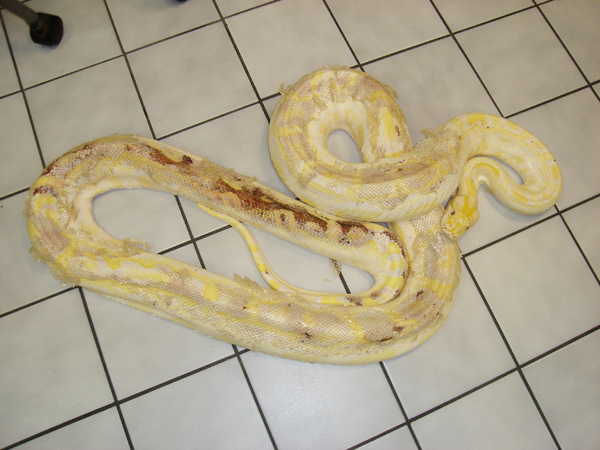
Douglas Mader
This python has not eaten in several months, was covered with mites, was septic with bacteria, had pneumonia and an underlying viral disease. There is no rule that a snake can have one disease.
Not so much anymore, but back when ball pythons were still being imported from the wild, it was commonplace for them to not eat once they were in captivity. A combination of many factors—stress, parasites, housing, food type and more—created a condition called “maladaptation syndrome,” also known as a “failure to thrive.” Regardless of what was done, many of these ball pythons never ate and eventually wasted away.
Husbandry deficiencies (housing, temperature, lighting, humidity, nutrition) are by far the most common causes for anorexia. Any medical issue has the potential of causing anorexia. Obvious events, such as trauma, can either physically preclude an animal from eating (a broken jaw, for example) or cause enough pain that the animal refuses to eat.
Not so obvious are the internal diseases—infectious, metabolic or organic. Again, an animal with severe pneumonia that is struggling for each breath will not eat. Animals in liver or kidney failure are metabolically deranged and this suppresses their appetite.
When an animal becomes anorectic you can’t just “force feed” them, thinking that as long as they get calories they will be cured. While it is true that nutritional support is often necessary to help an ill snake get strong enough to recover from their ailment, the underlying cause must be addressed for the animal to make a complete recovery.
Vomiting/Regurgitation in Snakes
Following along the lines of anorexia, another common presenting condition is vomiting/regurgitation. “Vomiting” refers to food that is expelled from the lower gastrointestinal tract (below the stomach), and “regurgitation” refers to food that is expelled from the stomach and above. The distinction may seem insignificant, but from a medical perspective, it makes a difference.
The most common cause for either condition usually stems from husbandry or management problems. The two most common causes in snakes are low environmental temperature and handling the animal too soon after eating.
I would say that these two conditions account for approximately 90 percent of the vomiting/regurgitation problems seen. Fortunately, these are easily diagnosed. A thorough examination of your husbandry and management practices should reveal the problem areas. If you have questions, have an expert review your management practices.
There are a number of other causes that make up the remaining 10 percent of cases. There are several diseases that can cause a snake to vomit or regurgitate shortly after taking a meal. Examples include bacteria and fungal infections, viruses, parasites, obstructions, cancer, kidney, liver and pancreatic diseases, and brain damage. The diagnosis of some of these conditions can be as simple as examining a routine fecal sample or as intricate as performing elaborate laboratory tests or even an MRI. Unfortunately, some of these latter tests can be quite costly.
The bottom line here is that if your snake is having problems with vomiting or regurgitation, thoroughly review your husbandry. If all is good, then you need to take your snake to the veterinarian for a more thorough physical evaluation.
Infectious Stomatitis or Mouth Rot in Snakes
“Mouth rot,” or infectious stomatitis as it is called in medical terms, is not a primary disease. This generally refers to any disease condition that affects the teeth and gums. Just as with anorexia, infectious stomatitis is a consequence of some other, generally serious, underlying condition. The infection in the mouth occurs when snakes are immunocompromised, or stressed, from some other cause.
Snakes kept under poor husbandry situations, with inadequate nutrition or concurrent disease (e.g. mites) and the like, are all disposed to develop infectious stomatitis.
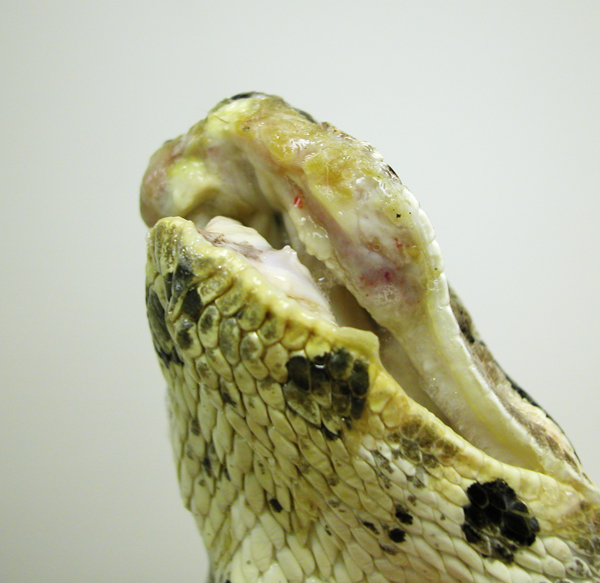
Douglas Mader
“Mouth rot,” or infectious stomatitis as it is called in medical terms, is not a primary disease.
Infectious stomatitis can be a consequence of injury, such as rostral trauma (rubbing the cage with the nose) and bites from prey. Again, there has to be a cause for the mouth infection.
A thorough physical examination is mandatory for proper diagnosis and treatment. The physical examination will include a hands-on evaluation. Laboratory testing, such as blood tests, bacterial cultures and x-rays, may also be necessary.
Minor cases often respond well to correction in husbandry deficiencies, antimicrobials and, if needed, pain medication. More serious cases, such as those resulting from broken bones (a misdirected strike into the glass), bone infection or cancer usually require substantially more effort, and generally cost. Needless to say, it is important to have the snake examined by a qualified veterinarian to determine the cause before any treatment is initiated.
Pneumonia (Respiratory) in Snakes
As mentioned at the beginning of the article, “respiratory” is a lay term often used in herpetological circles. The word refers to any ailment involving the nasal cavity, the airways or the lungs. In fact, respiratory illnesses can range from a stuffy nose to fulminate pneumonia. The sad truth is that for many reptiles, by the time they are presented to the veterinarian, they are already suffering from advanced disease.
A common presenting “sign” for many sick reptiles is a nasal discharge (in other words, a snotty nose). A discharge from the nose may simply be an upper respiratory problem and easily treated with antibiotics. Often times, however, this may be a component of progressed disease and associated with pneumonia in the lower respiratory tract. Pneumonia in reptiles is a very serious disease and one that can result in high mortality.
Respiratory infections in snakes can occur anywhere from the nostrils to the trachea (wind pipe) to the lung(s) and air sacs. Snakes lack a diaphragm and are unable to cough. As a result, if their lungs fill with fluid, such as pus, as happens with pneumonia, they have extreme difficulty breathing. These affected snakes may posture, that is, prop themselves in the cage, head and neck held up, with an open mouth. Gravity keeps the pulmonary fluid in the dependent portion of the lung(s), keeping the airway open to allow breathing. This is generally a sign of a very sick snake.
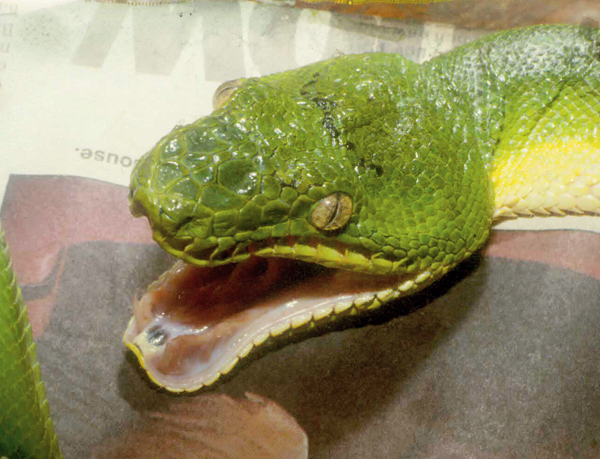
DOUGLAS MADER
Open-mouth breathing is never normal in snakes. Although the most likely cause is a respiratory condition, it can also be seen with gastrointestinal disease and severe pain.
Most respiratory problems are rooted in poor husbandry. If a reptile is not housed at its POTZ (preferred optimal temperature zone) it can become stressed. Over time, this will depress the animal’s immune system, predisposing it to disease. Without a properly functioning immune system, the body is unable to attack and defeat bacteria or other disease-causing agents, such as viruses, fungi, bacteria and parasites, that ordinarily wouldn’t cause a problem.
Humidity is a key factor in treating many respiratory diseases, but it is also a key factor in the cause of many infections. A desert species placed in a high-humidity environment will not have the ability to cope with the excess water vapor in its lungs. The reverse is also true when high-humidity species are kept in too dry a climate. The mucous that helps keep the lungs moist and allows the removal of dust will simply dry up, and infection will soon set in.
Nutritional issues (such as a vitamin-A deficiency), lung mites, various parasites and other organisms can all predispose a snake to respiratory disease. This is the reason why some reptile patients seemingly respond well to antibiotics. The antibiotic treats the secondary infection, but then, as soon as the drugs are finished, they break with pneumonia once again shortly thereafter.
Most pathogens (bacteria, viruses, fungi) are opportunists. In normal situations, when the host is healthy, the organisms will either coexist with the host or be eliminated by its healthy immune system. When the host is stressed and the immune system is compromised, these organisms become disease-causing agents.
One of the challenges a veterinarian must face when diagnosing respiratory disease is determining which organisms are actually causing the disease, and which ones are incidental findings that don’t actually need to be treated.
While some snakes with “respiratory” may respond well to a course of antibiotics, it is clear that not all will. If a snake has a refractory respiratory infection, a thorough examination will be needed to determine the cause. Bacterial culture and sensitivity testing, pulmonary washes, cytology and X-rays may all be needed. In advanced cases, MRI, CT or endoscopy might be used to get to the root cause of the disease. Blood tests, as well as viral screening, can also be done as a diagnostic aid. This is especially important when there are multiple snakes in a collection.
Dysecdysis or Retained Eye Cap
Improper shedding and retained eye caps, or dysecdysis, is a symptom of a problem, not a primarily problem itself (that is, dysecdysis is not a disease but rather a symptom of a disease).
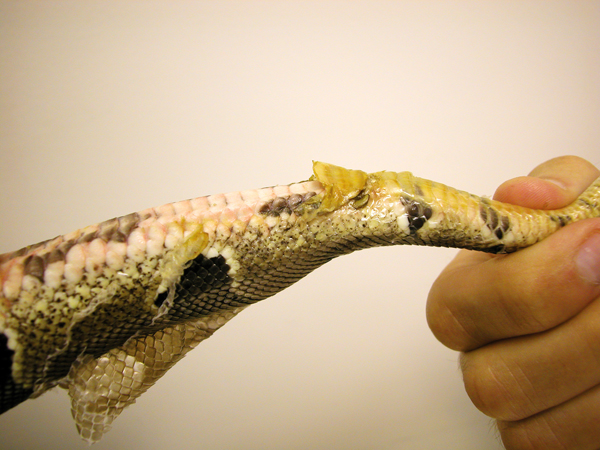
Douglas Mader
Dysecdysis in a ball python. The animal had a severe mite infestation, became septic with bacteria and then was not able to shed normally.
Skin shedding, or ecdysis, is a dynamic function that actually occurs throughout the lifetime of a snake. As soon as one shed cycle is completed, a new cycle is begun. This repeats itself until the animal dies of old age or from some other cause.
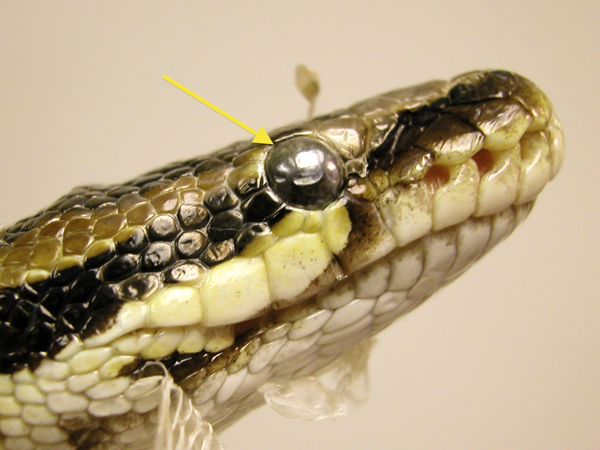
Douglas Mader
Retained eye cap in a ball python (arrow). It is not uncommon for snakes to retain an eye cap when they have problems with their shed cycles.
A healthy snake sheds its skin in a single piece (like an inverted sock). The length of the shedding cycle depends on a number of factors. Two factors which are very important are age of the animal and nutritional state. A young animal on a good diet will shed more than other groups of snakes. A healthy, growing snake can be expected to shed at least once a month.
The average period of time from the first visible sign of shedding to the actual sloughing of the old skin takes about seven to 14 days. It begins with a subtle dulling of the skin. After a few days, the skin becomes markedly dull and the eyes turn a whitish blue. This is the stage where the snake is said to be “in the blue” or “opaque,” to use the vernacular expression.
During this time, the snake will usually refuse food. Also, and more importantly, the underlying skin is not fully developed at this stage, and handling the animal can cause severe damage to the new skin
This dulling over is followed by a three- to four-day period, where the skin looks shiny and the eyes return to being clear. The skin is still easily damaged by rough handling, so care must be taken when touching the animal. At the end of this phase, the snake begins to seek out rough objects in its cage, such as branches or rocks, which it can use to start its shedding process.
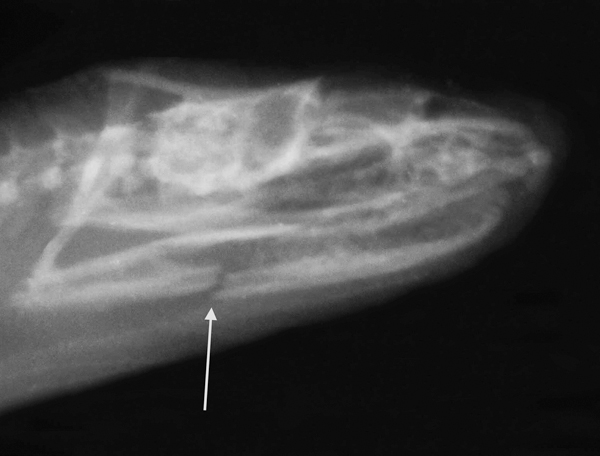
DOUGLAS MADER
This snake was not able to eat. An X-ray showed the reason—a broken jaw from accidentally striking the terrarium glass (arrow).
The snake will rub the skin off the tip of its nose and lower jaw first. It continues to rub on cage furniture until the loose skin snags on an object. Once this occurs, it can then proceed to crawl through the remainder of its skin, inverting it back over its body as it moves along. The final shed should be one complete, but inverted snake skin.
Whenever a snake sheds, you should always check that the spectacles, or eye caps, come off with the shed. The spectacles act as clear eyelids, which protect the snake’s corneas from damage. If an eye cap gets stuck, or is retained, as it is often called, the underlying eye may become infected.
The majority of shedding problems seen in snakes are due to husbandry and management problems. The aforementioned issue of handling a snake during its shedding cycle and causing severe damage to the developing new skin is a good example of a situation that may result in dysecdysis. Other management factors that cause improper shedding include: low cage temperatures, low humidity, improper nutrition and insufficient cage furniture (logs, rocks, etc.) for rubbing. Once these husbandry factors are corrected, the shedding should return to normal.
If changes in management and husbandry techniques cannot rectify the dysecdysis problems, then a veterinary consultation should be obtained. There are many medical cases of dysecdysis. Although they are far less common than the management problems already discussed, they are frequent enough that they bear mentioning: fungal skin disease; systemic diseases, such as septicemia, mites and microfilaria (parasites); thermal burns and old scars. As with any health problem in snakes, if the obvious causes are not responsible, an appointment with a snake-savvy reptile veterinarian is needed.
Acariasis
Infestation with mites and ticks, called acariasis, is not only a nuisance, but it can be associated with disease and potentially a costly problem in any reptile collection. Fortunately, once the ectoparasites have been identified, they can be treated.
The most commonly seen ectoparasite in snakes is the snake mite (Ophionyssus natricis). Adult mites are hematophagous, meaning that they suck blood, and in large numbers, they can debilitate a host (snake) by causing a life-threatening anemia. In addition, the mites can act as vectors of disease as they travel from animal to animal or cage to cage.
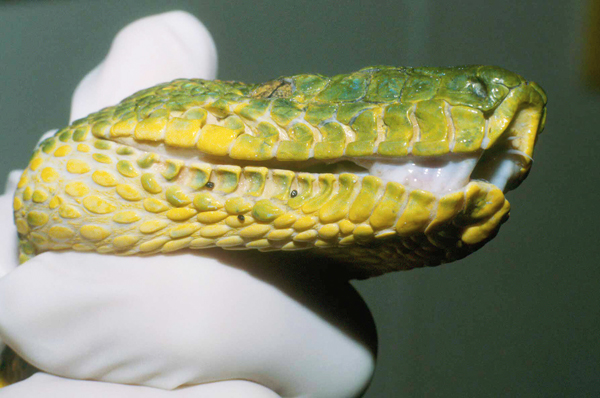
Douglas Mader
Snake mites tend to hitchhike between the scales, in the labial pits and around the folds of the eye caps.
Acariasis is commonly associated with unsanitary cage conditions, poor husbandry practices and recent imports or acquisitions. Mites commonly enter a collection arriving on newly acquired animals that have not been quarantined properly. Once established in a cage, mites can quickly spread to other animals throughout a collection.
The snake mite has been implicated as a vector for various infectious disease-causing agents in reptiles, such as Aeromonas hydrophila, Leukocytozoon and certain hematozoans. Aeromonas hydrophila is a bacteria commonly associated as a cause of pneumonia and infectious stomatitis. There has also been speculation that mites may be involved in the transmission of inclusion body disease of boid snakes, but this has not been proven.
Mite infestations can be anywhere from subtle (mites hiding in the skin folds under the jaw) to obvious (mites covering the entire animal with additional mites crawling all over the cage). The mites vary in color depending on the species, sex of the mite, the age of the mite and how recently it has taken a blood meal.
Mite-infested animals will usually have a dull, lackluster appearance. The mites tend to accumulate in areas of the reptile’s body that afford the most protection from the environment. These areas include the area under the chin, or gular folds in snakes, under the scutes, the periocular regions around the eyes and inside the skin folds around the cloaca.
In a large collection, mites and ticks can be extremely difficult to eradicate. Even in an individual pet, ectoparasites are a source of disease and debilitation. The parasites are easily diagnosed, and with the right plan, can be exterminated. The most important point here is that it is not just the snake that needs to be treated, but the entire cage/room/facility. If the environment is not treated, the mites and ticks will come back. Since some of the suggested treatments can be just as toxic to the patient as they can be to the pests, it is wise to get advice from someone with experience.
Pet Snake Diseases and Conditions
These problems are just the tip of the iceberg of snake diseases, representing the most common conditions that I see in my hospital. Gout, vascular emboli, cancer and neurological diseases are examples of several other diseases. In addition, there is no rule that a snake has to only have one disease. It is not uncommon to see a snake that has not eaten in months, has mites, is emaciated, is septic (bacterial infection), has pneumonia and is immunocompromised by a viral infection.
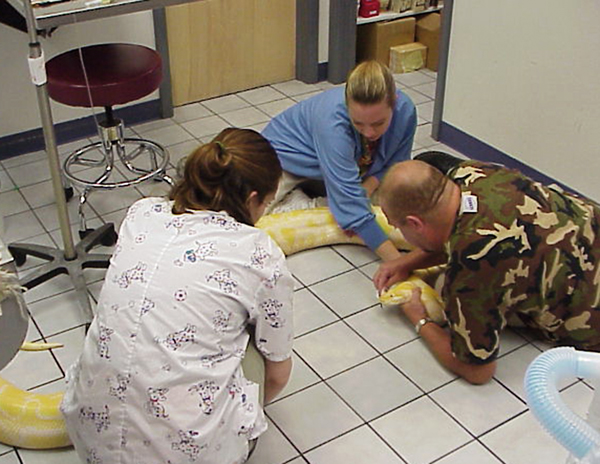
Douglas Mader
Establish a relationship with your herp veterinarian and get regular check ups on your snakes. It is easier to prevent problems than treat them once they develop. Pictured here: Several veterinary professionals perform a routine exam on a Burmese python.
A common thread for many of these conditions is bad husbandry. In fact, to be a good snake doctor, you have to be a good amateur herpetologist as well. If you don’t know the normal, you will never be able to recognize the abnormal.
I’ve been doing this for a long time. That said, I am the first to admit “I don’t know” when it comes to some of the more unusual species. I count on working with my clients to maximize the health care for their snakes. Find a good, experienced herp vet and establish a relationship with them. That way, when a problem does arise, you are not in a panic, trying to find someone who can help.
Finally, it is always best to prevent disease rather than treat a problem once it happens. Make it a point to have your snakes examined by your veterinarian on a regular basis.
Douglas R. Mader, MS, DVM, DABVP (REPTILE/AMPHIBIAN), is a graduate of the University of California, Davis. He owns the Marathon Veterinary Hospital in the Conch Republic, and is a world-renowned lecturer, author and editor. He sits on the review boards of several scientific and veterinary journals.



